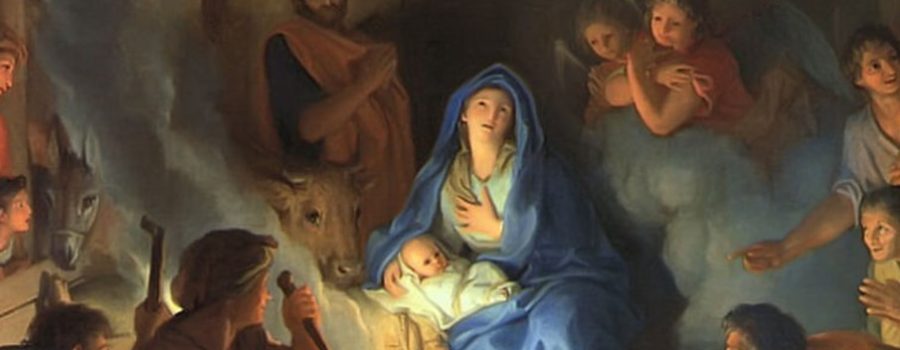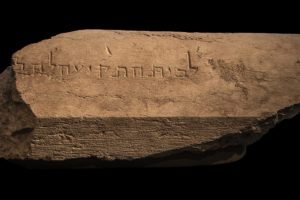During the Christmas season many Christian people hear about Joseph and Mary arriving in Bethlehem for a Roman census ordered by Emperor Augustus. When they arrived, they found there was no place to stay for the inns were full. As Mary was due, a kind owner of an inn permitted the couple to stay in his stable. Mary had her baby, Jesus, in the stable, wrapped him in swaddling clothes, and laid him in the manger. There they were visited by local shepherds.
Sometime later, three wise men, also known as magi, saw a brilliant star in the night sky resting over the place where Jesus was born. The wise men then traveled from a distant eastern country to find the new king. In many churches across America there are reenactments of these events often by children attending a church’s Sunday School department.
The biblical account is far different than the traditional story above as memorialized in awesome paintings such as The Adoration of the Shepherds by French painter Charles Lebrun shown above. As court painter, French King Louis XIV declared Lebrun “the greatest French artist of all time.” Lebrun was a dominant figure in 17th-century French art. Let us examine what the Bible actually reveals about Christ’s birth.
No room at the Inn?
The evangelist Luke states, “And she gave birth to her firstborn son; and she wrapped Him in cloths, and laid Him in the manger, because there was no room for them in the inn” (Luke 2:7 NASB). Why was there no room at the inn?
The Greek word translated “inn” here is kataluma. It means a place of rest, usually a guest room. In fact, the same writer Luke uses this very word later where it clearly refers to a guestroom and not an inn. Notice Luke 22:11 NASB, where Jesus said to His disciples, “Then you shall say to the master of the house, ‘The Teacher says to you, Where is the guest room [kataluma ] where I may eat the Passover with My disciples?’”
A careful reading of the text shows us they had already been at Bethlehem for some days when she went into labor. Notice carefully Luke 2:4-6 NASB: “Joseph also went up from Galilee, out of the city of Nazareth into Judea, to the city of David, which is called Bethlehem, because he was of the house and lineage of David, to be registered with Mary, his betrothed wife, who was with child. So it was, that while they were there, the days were completed for her to be delivered.” Consequently, they had been lodging somewhere at Bethlehem when her birth pangs began.
At Genesis 35:19-21 NASB, we are told that when Rachel died, after giving birth to Benjamin, the youngest son of Jacob, her husband buried her on the way to Ephrath (Bethlehem), set a pillar (a monument or stone memorial) on her grave, and then journeyed and pitched his tent beyond the tower of Eder. This agricultural watchtower tower called Migdal Eder or Migdal-eder (Tanach) appears in the Hebrew Scriptures in Micah 4.
As for you, tower of the flock,
Hill of the daughter of Zion,
To you it will come—Yes, the former dominion will come,
The kingdom of the daughter of Jerusalem. (Micah 4:8 NASB).
As there was no room at the inn, Jesus’ birth in fact occurred at the ancient watchtower near Bethlehem of Judea (Edersheim, The Life and Times of Jesus the Messiah, 1962, pp. 186-187). This would place Jesus’ birth at the traditional place for birthing sacrificial lambs. Migdal Eder (“Tower of the Flock”) was not a watchtower for ordinary flocks. The New Testament presents Jesus as being “in antitype” as a sacrificial lamb (John 1:29, 1:36; 19:36 NASB; Revelation 5:6-14 NASB). Jesus, born at Migdal Eder was the sacrificial Lamb of God.

Luke 2:8-18 NASB states that at Jesus’ birth, there were shepherds in the sheep fields near Bethlehem, keeping watch through the watches of the night. Routinely, shepherds had three-hour shifts. At the point of Jesus’ birth, they were pasturing their flocks some distance from Bethlehem, presumably an hour or so by foot, in the newly grassed pasturelands of the Judean hills for the season of late summer/early autumn rains had begun. Luke’s Gospel reports that an “angel of the Lord” told the shepherds:
“Do not be afraid; for behold, I bring you good news of great joy which will be for all the people; for today in the city of David there has been born for you a Savior, who is Christ the Lord.” (Luke 2:10-11 NASB).
They would find the baby wrapped in swaddling clothes and lying in the manger. Jesus’ birth occurred at Bethlehem in the autumn when the Temple flocks were near (in the Judean hills). The shepherds were within reasonable walking distance, perhaps an hour or so, of the birthing place for the sacred sacrificial flock at Migdal Eder.
The shepherds knew the prophecy of the Prophet Micah concerning the Messiah. Micha 5:2 NASB states that the Messiah would come forth from Bethlehem.
But as for you, Bethlehem Ephrathah,
Too little to be among the clans of Judah,
From you One will go forth for Me to be ruler in Israel.
His goings forth are from long ago,
From the days of eternity. (Micha 5:2 NKJV).
Later, when Herod the Great (Roman client king of Judah (37-1 BCE) learned that the wise men were searching for the recently born King of the Jews, he asked the Jewish religious leaders where the Messiah King was to be born. The priests and scribes quoted the same verse from the book of Micah and said, “In Bethlehem of Judea, for thus it is written by the prophet” (Matthew 2:5-6 NASB).
The shepherds knew that the Messiah King would come to the “the tower of the flock.” As the priest-shepherds of Migdal Eder, there was no need for an angel to provide them with detailed directions to the birthplace. When the angelic announcement came, as they who raised the sacrificial lambs for sacrifice at the Temple, already knew the exact location of the birthplace.
Why were Joseph and Mary at Bethlehem?
In the twelfth year of Augustus’ proconsulship (4 BCE), he required all his subjects, including those in client kingdoms, to register and take a loyalty oath. The purpose of the registration was not taxation. It was a political action in preparation for the Roman Senate later declaring him Pater Patriae, a Latin honorific meaning “Father of the Fatherland.” The Senate ultimately voted the title to Caesar Augustus in 2 BCE.
Interestingly, in context it seems the paranoid Herod the Great used the occasion to ferret out and deal with his real and imagined enemies including identifying all those of royal Judaic lineage so he would know who were all the potential claimants to the royal throne of David residing in his kingdom. While the Jews went “into his own city” (Luke 2:3) Herod and the Romans sought the loyalty oath of adult men.
Those of royal Judaic lineage, apparently both men and women, because of the political implications had to register and take the loyalty oath at Bethlehem. The underlying reason both Joseph and Mary as royals, descendants of King David as recorded in the genealogical registers in the Temple archives, journeyed to Bethlehem to take the oath of allegiance and confirm their registration was because they belonged to the royal house of King David.
Of the 600 Pharisees at Jerusalem who were put to death because they refused to take the oath there is no indication that their wives were put to death as well. Men were a threat; women were considered human chattel.
Joseph and Mary came to Bethlehem in 4/3 BCE for a declaration, a required oath of allegiance to Caesar Augustus (Roman emperor 27 BCE-14 CE) by those residing in a client state, to which Luke refers as a “registration.” While everyone went “into his own city” (Luke 2:3 NASB) to their own localities, those of royal Judaic lineage because of political implications had to register in Bethlehem a small village of about 400 people. A better translation of Luke 2:1-5 would read:
“Caesar Augustus issued a decree that a registration should be taken of the entire Roman world.(This registration was before Quirinius governed Syria.) And everyone went to their own town to register.
So, Joseph also went up from the town of Nazareth in Galilee to Judea, to Bethlehem the town of David, because he belonged to the house and line of David. He went there to register with Mary, who was pledged to be married to him and who was pregnant.”
This requirement allowed Herod, a vicious tyrant, to know the identities of all claimants in Judaea to the royal throne of David. He was anxious to know who all these people were to keep them subjected to thorough non-political functions such that his own dynasty would survive. The explanation is that in the twelfth year of his proconsulship, Caesar Augustus required all of his subjects, including those in client kingdoms, to register and take a loyalty oath. The decree did not pertain to taxation, it was a political action in preparation for the Roman Senate declaring him Pater Patriae, a Latin honorific meaning “Father of the Fatherland.” On February 5, 2 BCE the Senate declared Augustus the title quite apart from the later census in 6/7 CE when Quirinius was Governor of Syria.
In what year was Jesus born?
The first year of Herod as King by inclusive reckoning was 37/36 (Ni/Ni), beginning Nisan 1, 37 BCE. Temple reconstruction began in Herod’s eighteenth regal year. It was from March 26, 20 BCE, or Nisan 1, 3741 AM (734 AUC), to March 15, 19 BCE or Nisan 1, 3742 AM (735 AUC).
The first Passover in Jesus’ ministry (March 29, 28 CE). Jesus’ then began his public ministry when he was then 30 years old. Second Temple reconstruction had lasted for forty-six years (John 2:20 NASB). The first year being 20/19 BCE or 3742 AM, necessitates the 46th year to be 27/28 BCE or 3788 AM. Thus Jesus was aged 30 in 27/28 CE placing his birth in 4 BCE.
In what year did Herod die?
The Gospels place the birth of Jesus at Bethlehem of Judea before the death of Herod. Herod named his sons as his successors (Herod Archelaus as ethnarch, Herod Antipas and Philip as tetrarchs) with the consent of Augustus. The emperor antedated their succession on Herod the Great’s death to 4 BCE.
First-century Jewish historian Flavius Josephus in his Antiquities of the Jews tells of a lunar eclipse in the final year of Herod’s life (Josephus, Antiquities 17.6.4§167); (Whiston, 1987, p. 462). The only eclipse that reasonably meets Josephus’ description, and allows for the 4 BCE birth and a 31 CE crucifixion of Jesus of Nazareth, began about midnight January 10, 1 BCE. This total lunar eclipse would place Herod’s death in 1 BCE.



Recent Comments